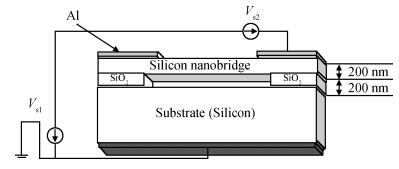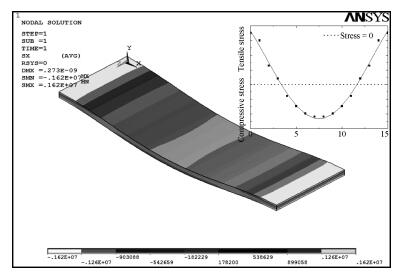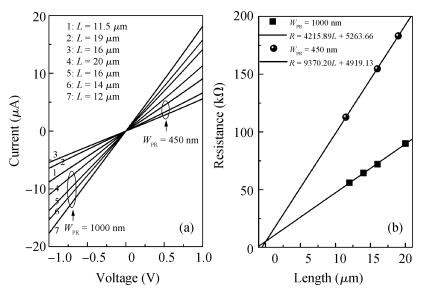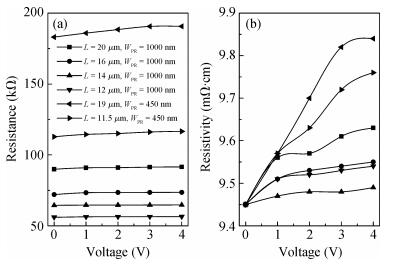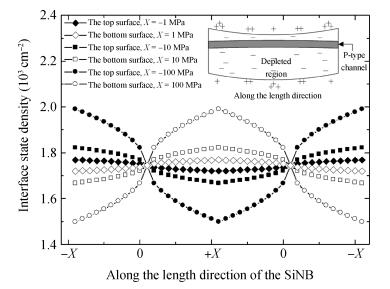| Citation: |
Jiahong Zhang, Qingquan Liu, Yixian Ge, Fang Gu, Min Li, Xiaoli Mao, Hongxia Cao. Extraction of interface state density and resistivity of suspended p-type silicon nanobridges[J]. Journal of Semiconductors, 2013, 34(5): 052002. doi: 10.1088/1674-4926/34/5/052002
****
J H Zhang, Q Q Liu, Y X Ge, F Gu, M Li, X L Mao, H X Cao. Extraction of interface state density and resistivity of suspended p-type silicon nanobridges[J]. J. Semicond., 2013, 34(5): 052002. doi: 10.1088/1674-4926/34/5/052002.
|
Extraction of interface state density and resistivity of suspended p-type silicon nanobridges
DOI: 10.1088/1674-4926/34/5/052002
More Information
-
Abstract
The evaluation of the influence of the bending deformation of silicon nanobridges on their electrical properties is crucial for sensing and actuating applications. A combined theory/experimental approach for determining the resistivity and the density of interface states of the bending silicon nanobridges is presented. The suspended p-type silicon nanobridge test structures were fabricated from silicon-on-insulator wafers by using a standard CMOS lithography and anisotropic wet etching release process. After that, we measured the resistance of a set of silicon nanobridges versus their length and width under different bias voltages. In conjunction with a theoretical model, we have finally extracted both the interface state density of and resistivity suspended silicon nanobridges under different bending deformations, and found that the resistivity of silicon nanobridges without bending was 9.45 mΩ·cm and the corresponding interface charge density was around 1.7445×1013 cm-2. The bending deformation due to the bias voltage slightly changed the resistivity of the silicon nanobridge, however, it significantly changed the distribution of interface state charges, which strongly depends on the intensity of the stress induced by bending deformation. -
References
[1] Cui Y, Zhong Z H, Wang D L, et al. High performance silicon nanowire field effect transistors. Nano Lett, 2003, 3(2):149 doi: 10.1021/nl025875l[2] Li X X, Ono T, Wang Y L, et al. Ultrathin single-crystalline-silicon cantilever resonators:fabrication technology and significant specimen size effect on Young's modulus. Appl Phys Lett, 2003, 83(15):3081 doi: 10.1063/1.1618369[3] Li D, Wu Y, Kim P, et al. Thermal conductivity of individual silicon nanowires. Appl Phys Lett, 2003, 83(14):2934 doi: 10.1063/1.1616981[4] He R R, Yang P D. Giant piezoresistance effect in silicon nanowires. Nature Nanotechnology, 2006, 1:42 doi: 10.1038/nnano.2006.53[5] Yang Y L, Li X X. Giant piezoresistance of p-type nano-thick silicon induced by interface electron trapping instead of 2D quantum confinement. Nanotechnology, 2011, 22(1):015501 doi: 10.1088/0957-4484/22/1/015501[6] Zhang Jiahong, Huang Qing'an, Yu Hong, et al. A theoretical study of the piezoresistivity of a p-type silicon nanoplate. Journal of Semiconductors, 2008, 29(5):970 http://www.jos.ac.cn/bdtxbcn/ch/reader/view_abstract.aspx?file_no=07093004&flag=1[7] Chuai Rongyan, Liu Bin, Liu Xiaowei, et al. Tunnelling piezoresistive effect of grain boundary in polysilicon nano-films. Journal of Semiconductors, 2010, 31(3):032002 doi: 10.1088/1674-4926/31/3/032002[8] Brönstrup G, Jahr N, Leiterer C, et al. Optical properties of individual silicon nanowires for photonic devices. ACS Nano, 2010, 4(12):7113 doi: 10.1021/nn101076t[9] Fernandez-Sierra M V, Adessi C, Blase X. Conductance, surface traps, and passivation in doped silicon nanowires. Nano Lett, 2006, 6(12):2674 doi: 10.1021/nl0614258[10] Vo T, Williamson A J, Galli G. First principles simulations of the structural and electronic properties of silicon nanowires. Phys Rev B, 2006, 74:045116 doi: 10.1103/PhysRevB.74.045116[11] Vaurette F, Nys J P, Deresmes D, et al. Resistivity and surface states density of n-and p-type silicon nanowires. J Vac Sci Technol B, 2008, 26(3):945 doi: 10.1116/1.2908438[12] Kimukin I, Islam M S, Williams R S. Surface depletion thickness of p-doped silicon nanowires grown using metal-catalysed chemical vapour deposition. Nanotechnology, 2006, 17:S240[13] Park J T, Kim J Y, Islam M S. Extraction of doping concentration and interface state density in silicon nanowires. IEEE Trans Nanotechnol, 2011, 10(5):1004 doi: 10.1109/TNANO.2010.2094203[14] Schmidt V, Senz S, Gösele U. Influence of the Si/SiO2 interface on the charge carrier density of Si nanowires. Appl Phys A, 2007, 86(2):187[15] Sato S, Li W, Kakushima K, et al. Extraction of additional interfacial states of silicon nanowire field-effect transistors. Appl Phys Lett, 2011, 98(23):233506 doi: 10.1063/1.3598402[16] Zhang J H, Mao X L, Liu Q Q, et al. Mechanical properties of silicon nanobeams with undercut evaluated by combining dynamic resonance test and finite element analysis. Chin Phys B, 2012, 21(8):086101 doi: 10.1088/1674-1056/21/8/086101[17] Diarra M, Niquet Y M, Delerue C, et al. Ionization energy of donor and acceptor impurities in semiconductor nanowires:importance of dielectric confinement. Phys Rev B, 2007, 75:045301 doi: 10.1103/PhysRevB.75.045301[18] Sadeghian H, Yang C K, Goosen J F L, et al. Effects of size and defects on the elasticity of silicon nanocantilevers. J Micromech Microeng, 2010, 20:064012 doi: 10.1088/0960-1317/20/6/064012[19] Zhang Xingli, Sun Zhaowei. Effects of vacancy structural defects on the thermal conductivity of silicon thin films. Journal of Semiconductors, 2011, 32(5):053002 doi: 10.1088/1674-4926/32/5/053002[20] Zhu Huiwen, Liu Yongsong, Mao Lingfeng, et al. Theoretical study of the SiO2/Si interface and its effect on energy band profile and MOSFET gate tunneling current. Journal of Semiconductors, 2010, 31(8):082003 doi: 10.1088/1674-4926/31/8/082003[21] Sze S M. Physics of semiconductor devices. New York: John Wiley & Sons, 1981[22] Li G, Aluru N R. A Lagrangian approach for quantum-mechanical electrostatic analysis of deformable silicon nanostructures. Engineering Analysis with Boundary Elements, 2006, 30(11):925 doi: 10.1016/j.enganabound.2006.03.012[23] Nghiêm T T T, Aubry-Fortuna V, Chassat C, et al. Monte Carlo simulation of giant piezoresistance effect in p-type silicon nanostructures. Mod Phys Lett B, 2011, 25(12/13):995[24] Rowe A C H. Silicon nanowires feel the pinch. Nature Nanotechnology, 2008, 3:311 doi: 10.1038/nnano.2008.108[25] Angermann H, Henrion W, Röseler A, et al. Wet-chemical passivation of Si (111)-and Si (100)-substrates. Mater Sci Eng B, 2000, 73(1):178 -
Proportional views





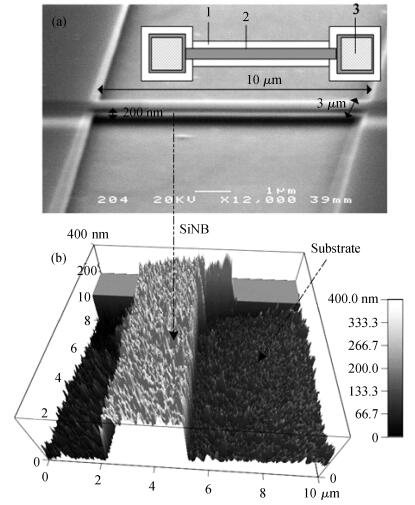
 DownLoad:
DownLoad:
